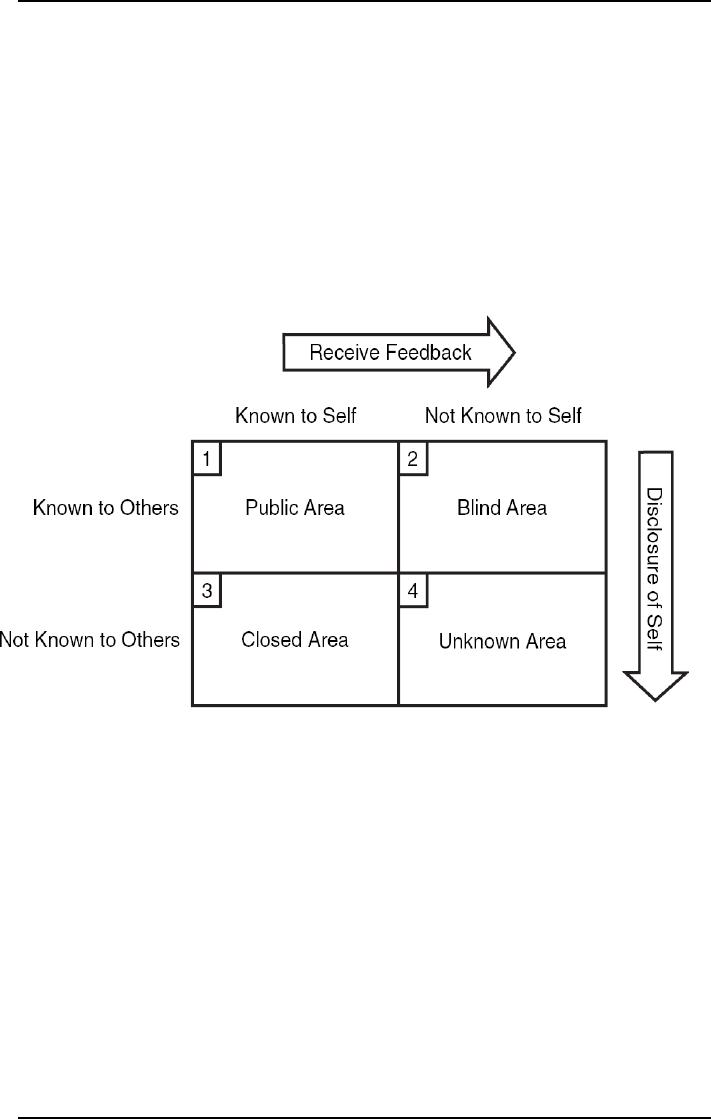 |

Organization
Development MGMT
628
VU
Lesson
28
Interpersonal
and Group Process
Approaches
Process
Interventions:
Process
interventions are in OD skill
used by OD practitioners, whether managers or OD
professionals, to
help
work groups become more
effective. The purpose of process
interventions is to help the work
group
become
more aware of the way it
operates and the way its
members work with one
another. The work
group
uses this knowledge to develop its own
problem-solving ability. Process
interventions, then, aim at
helping
the work group to become
more aware of its own
processes, including the way it
operates, and uses
this
knowledge to solve its own
problems.
The
manager practicing process intervention
observes individuals and
teams in action and helps them
learn
to
diagnose and solve their
own problems. The manger
refrains from telling them
how to solve their
problems
but instead asks questions,
focuses their attention on
how they are working together,
teaches or
provides
resources where necessary,
and listens. On of the major advantages
is that teams becomes
more
independent
to solve problems.
Now
we will discuss change
programs relating to interpersonal relations and
group dynamics. These
change
programs
are among the earliest ones
devised in OD and represent
attempts to improve people's
working
relationships
with one another. The
interventions are aimed at
helping group members assess
their
interactions
and devise more effective
ways of working together. These
interventions represent a basic
skill
requirement
for an OD practitioner.
Interpersonal
relationships and group dynamics,
involve four types of
interventions:
1.
T-group.
2.
Process consultation.
3.
Third-party intervention.
4.
Team building.
1.
T-Groups
As
discussed earlier, sensitivity training, or the
T-group, is an early forerunner of modern
OD
interventions.
Its direct use in OD has
lessened considerably. The
National Training Laboratories
(NTL)
and
UCLA are among the few remaining
organizations that offer
T-groups on a regular basis.
OD
practitioners
often attend T-groups to improve
their own functioning. For
example, T-groups can help
OD
practitioners
become more aware of how
others perceive them and
thus increase their
effectiveness with
client
systems. In addition, OD practitioners
often recommend that organization
members attend a T-
group
to learn how their behaviors
affect others and to develop more
effective ways of relating to
people.
What
Are the Goals?
T-groups
traditionally are designed to
provide members with experiential
learning about group dynamics,
leadership,
and interpersonal relations. The
basic T-group consists of ten to
fifteen strangers who
meet
with
a professional trainer to explore the social
dynamics that emerge from
their interactions. Modifications
of
this basic design have
generally moved in two directions. The
first path has used
T-group methods to
help
individuals gain deeper
personal understanding and development.
This intrapersonal focus typically
is
called
an encounter group or a personal-growth group. It
generally is considered outside the
boundaries of
OD
and should be conducted only by
professionally trained clinicians. The
second direction uses
T-group
techniques
to explore group dynamics and
member relationships within an intact
work group. Considerable
training
in T-group methods and group
dynamics should he acquired before trying
these interventions.
This
group
focus has led to the OD intervention
called team building, which
is discussed later.
Extensive
review of the literature reveals that
there are six overall
objectives common to most
T-groups,
although
not every practitioner need
accomplish every objective in every
T-group. These objectives
are:
1.
Increased
understanding, insight, and
self-awareness about one's
own behavior and its
impact on
others,
including the ways in which
others interpret one's
behavior.
2.
Increased
understanding and sensitivity about the
behavior of others, including
better
interpretation
of both verbal and nonverbal
clues, which increases
awareness and understanding
of
what
other people are thinking
and feeling.
3.
Better
understanding and awareness of group
and inter-group processes,
both those that
facilitate
and
those that inhibit group
functioning.
4.
Increased
diagnostic skills in interpersonal and
inter-group situations. Accomplishing the
first three
objectives
provides the basic tools for
accomplishing the fourth
objective.
5.
Increased
ability to transform learning
into action so that
real-life interventions
will
be successful in increasing member
satisfaction, output, or
effectiveness.

Organization
Development MGMT
628
VU
6.
Improvement
in individuals' ability to analyze
their own interpersonal behavior as
well as to learn
how
to help themselves and
others with whom they come
in contact, achieve more
satisfying,
rewarding,
and effective interpersonal
relationships.
These
goals seem to meet many
T-group applications, although
any one training program may
emphasize
one
goal more than the others.
One trainer may emphasize understanding
group process as applied to
organizations;
another may focus on group
process as a way of developing
individuals' understanding of
themselves
and others; and a third
trainer may concentrate
primarily on interpersonal and
intrapersonal
learning.
Application
Stages
Application
4 illustrates the activities occurring in a typical unstructured
strangers T-group, one of the
most
popular
approaches.
Application
4: Unstructured Strangers
T-group
A
typical T-group session for
strangers might consist of
five or six T-groups of ten to
fifteen members who
have
signed up for a Session
conducted by the National Training
Laboratories, UCLA's Ojai program,
a
university,
or a similar organization. The T-group
sessions may be combined with
cognitive learning, such
as
brief lectures on general
theory, designed exercises, or
management games.
Each
T-group comprises people who
have not previously known
one another. If several people
from the
same
organization attend, they are put into
different T-groups. At the beginning of the training
session, the
trainer
makes a brief and ambiguous
statement about either his or her
role or some ground rules
and lapses
into
silence. Because the trainer has
not taken a leadership role
or provided goals for the group, a
dilemma
of
leadership and agenda is
created. The group must
work out its own
methods to proceed further; it
must
fill
the void left by the lack of a
leader or of group
objectives.
As
the group fills the void, the
individuals' behaviors become the
"here-and-now" basic data
for the
learning
experiences. As the group struggles
with procedure, individual
members try out different
behaviors
and
roles, many of which are
unsuccessful. One T-group member
might make a number of direct,
forceful,
and
unsuccessful attempts to take
over the leadership role, trying
first one style, then
another. Finally, he or
she
conspicuously withdraws from the group,
falls silent, and appears to
be thinking about other
things.
Group
members might observe that
this person has two basic
styles of working with
others; when one
style
is
unsuccessful, he or she adopts the
other--withdrawal.
As
appropriate, the trainer will make an
"intervention," an observation or comment
about the group, its
behavior
or the activities that are
taking place. The type and
nature of the intervention will
vary, depending
on
the purpose of the laboratory and the
trainer's own style. Usually, the trainer
encourages individuals to
understand
what is going on in the group, their own
feelings and behaviors, and
the impact their behavior
has
on themselves and others.
The primary emphasis is on the here-and-now
experience, rather than on
anecdotes
or "back at the ranch"
experiences.
The
emphasis on openness and leveling in a
supportive and caring
environment enables the participants
to
gain
insight into their own
and others' feelings and
behaviors. A better understanding of group
dynamics
also
can make them more
productive individuals.
2.
Process Consultation:
Process
consultation (PC) is a general framework
for carrying out helping
relationships. It is oriented to
helping
managers, employees, and
groups assess and improve
processes, such as communication,
interpersonal
relations, decision making and
task performance. Schein
argues that effective consultants
and
managers
should be good helpers, aiding others in
getting things done and in achieving the
goals they have
set.
Thus, PC is more a philosophy
than a set of techniques
aimed at performing this helping
relationship.
The
philosophy ensures that
those who are receiving the
help own their problems,
gain the skills and
expertise
to diagnose them, and solve
them themselves. Thus, it is an approach
to helping people and
groups
help themselves.
Schein
defines process consultation as "the
creation of a relationship that permits the
client to perceive,
understand,
and act on the process
events that occur in
(her/his) internal and external
environment in
order
to improve the situation as defined by the
client." The process consultant
does not offer expert
help
in
the form of solutions to problems, as in the
doctor-patient model. Rather, the process
consultant works
to
develop relationships, observes groups
and people in action, helps them diagnose
the way they are
carrying
out tasks, and helps them
learn how to he more
effective.
In
the OD literature, team building is not
clearly differentiated from
process consultation. This
confusion
exists
because most team building
includes process consultation--helping
the group diagnose
and
understand
its own internal processes.
However, process consultation is a more
general approach to
helping
relationships than is team building.
Team building focuses
explicitly on helping groups
perform

Organization
Development MGMT
628
VU
tasks
and solve problems more
effectively. Process consultation, on the
other hand, is concerned
with
establishing
effective helping relationships in organizations. It
is seen as key to effective management
and
consultation
and can be applied to any
helping relationship, from subordinate development to
interpersonal
relationships
to group development. Thus, team
building consists of process consultation
plus other, more
task-oriented
interventions.
Group
Process:
Process
consultation deals primarily with
five important interpersonal and
group processes;
1.
communications,
2.
the functional roles of group
members,
3.
the ways in which the group
solves problems and makes
decisions,
4.
group norms development,
and
5.
The use of leadership and
authority.
Communications
One
of the process consultant's areas of
interest is the nature and
style of communication at both the
overt
and
covert levels. At the overt level, communication
issues involve who talks to
whom, for how long,
and
how
often. One method for
describing group communication is to keep
a time log of how often and
to
whom
people talk. For example, at an
hour-long meeting conducted by a
manager, the longest
anyone
other
than the manager got to
speak was one minute, and
that minute was allotted to
the assistant manager.
Rather
than telling the manager
that he is cutting people off, the
consultant can give descriptive
feedback
by
citing the number of times others
tried to talk and the amount of time they
were given. The consultant
must
make certain that the
feedback is descriptive and
not evaluative (good or bad), unless the
individual or
group
is ready for evaluative
feedback.
By
keeping a time log, the consultant also can
note who talks and
who interrupts. Frequently,
certain
people
are perceived as being quiet, when in fact they
have tried to say something
and have been
interrupted.
Such interruptions are one
of the most effective ways of reducing
communications and
decreasing
participation in a meeting.
Body
language and other nonverbal
behavior also can be a
highly informative method
for understanding
communication
processes. For example, at another
meeting conducted by a manager, the
animated
discussion
at the start of the meeting was
interrupted by the second-in-command, who
said, "This is a
problem-solving
meeting, not a gripe session." As the
manager continued to talk, the
fourteen other
members
present assumed expressions of
concentration. Within twenty-five
minutes, all of them
had
folded
their arms and were
leaning backward, a sure
sign that they were blocking
out or shutting off the
message.
Within ten seconds of the manager's
subsequent statement, "We
are interested in getting
your
ideas,"
those present unfolded their
arms and began to lean
forward, a clear nonverbal
sign that they were
involved
once again.
The
manager uses several
techniques to analyze the communications
processes in a work group.
Observe.
How
often and how long
does each member talk
during a group discussion?
These observations
can
be easily recorded on paper
and referred to later when analyzing
group behavior. It is also
useful to
keep
a record of who talks to
whom.
Identify.
Who
are the most influential
listeners in the group? Noticing
eye contact between members
can
give
insights on the communication processes.
Sometimes one person, and
perhaps not even the
person
who
speaks most frequently, is the
one focused on by others as they
speak.
Interruptions.
Who
interrupts whom? Is there a pattern in
the interruptions? What are the
apparent
effects
of the interruptions?
The
manager will probably share
this information with the group to
enable the members to better
understand
how they communicate with
one another.
Feedback
may be given intermittently during the
meeting or at the conclusion of the
meeting. The purpose
of
feedback is to enable group
members to learn about the way they
communicate with one
another.
At
the covert or hidden level of communication, sometimes
one thing is said but
another meant, thus
giving
a double message. Luft has
described this phenomenon in what is called the
Johari Window. Figure
38,
a diagram of the Johari Window,
shows that some personal
issues are perceived by both
the individual
and
others (cell 1). Other
people are aware of their
own issues, but they conceal
them from others (cell
2).
People
with certain feelings about
themselves or others in the work
group may not share
with others unless
they
feel safe and protected; by not
revealing reactions they feel might be
hurtful or impolite, they
lessen
the
degree of communication.
Cell
3 comprises personal issues
that are unknown to the
individual but that are
communicated clearly to
others.
For example, an individual
may shout, "I'm not
angry," as he or she slams a
fist on the table, or
say,
"I'm
not embarrassed at all," as
lie or she blushes scarlet.
Typically, cell-3 communication conveys
double

Organization
Development MGMT
628
VU
messages.
For example, one manager
who made frequent business
trips invariably told his
staff to function
as
a team and to make decisions
in his absence. The staff, however
consistently refused to do this because
it
was
clear to them, and to the
process consultant, that the
manager was really saying,
"Go ahead as a team
and
make decisions in my absence,
but be absolutely certain they
are the exact decisions I
would make if I
were
here." Only after the manager
participated in several meetings in which
he received feedback was
he
able
to understand that he was
sending a double message. Thereafter, he
tried both to accept
decisions
made
by others and to use
management by objectives with
his staff and with
individual managers.
Cell
4 of the Johari Window represents
those personal aspects that
are unknown to either the individual
or
others.
Because such areas are
outside the realm of the process
consultant and the group, focus is
typically
on
the other three
cells.
The
consultant can encourage individuals to
be more open with others about
their views,
opinions,
concerns,
and emotions, thus reducing
cell 2. Further, the consultant can
help individuals give feedback
to
others,
thus reducing cell 3.
Reducing the size of these
two cells helps improve the
communication process
by
enlarging cell I, the "sell" that is open
to both the individual and
others.
Figure
38: Johari Window
Disclosure
and Feedback of Johari
Window:
As
indicated in Figure, movement along the vertical and
horizontal dimensions enables
individuals to
change
their interpersonal styles by increasing
the amount of communication in the public or shared
area.
To
enlarge the public area, a
person may move vertically by
reducing the closed area. As a
person behaves
less
defensively and becomes more
open, trusting and risk taking,
others will tend to react
with increased
openness
and trust. This process
termed, disclosure, involves the open
disclosure of one's
feelings,
thoughts
and candid feedback to
others. The openness of communication
leads more to open
and
congruent
relationships.
The
behavioral process used to enlarge the
public area horizontally
termed, feedback,
allows us to reduce
the
blind area. The only
way to become aware of our
blind spots is for others to
give information or
feedback
about our behavior.
The
blind area can only be
reduced with the help and
cooperation of others, and this requires
a willingness
to
invite and accept such
feedback.
Almost
every organization finds that
poor communication is the most important
problem preventing
organizational
effectiveness.
Table of Contents:
- The Challenge for Organizations:The Growth and Relevance of OD
- OD: A Unique Change Strategy:OD consultants utilize a behavioral science base
- What an “ideal” effective, healthy organization would look like?:
- The Evolution of OD:Laboratory Training, Likert Scale, Scoring and analysis,
- The Evolution of OD:Participative Management, Quality of Work Life, Strategic Change
- The Organization Culture:Adjustment to Cultural Norms, Psychological Contracts
- The Nature of Planned Change:Lewin’s Change Model, Case Example: British Airways
- Action Research Model:Termination of the OD Effort, Phases not Steps
- General Model of Planned Change:Entering and Contracting, Magnitude of Change
- The Organization Development Practitioner:External and Internal Practitioners
- Creating a Climate for Change:The Stabilizer Style, The Analyzer Style
- OD Practitioner Skills and Activities:Consultant’s Abilities, Marginality
- Professional Values:Professional Ethics, Ethical Dilemmas, Technical Ineptness
- Entering and Contracting:Clarifying the Organizational Issue, Selecting an OD Practitioner
- Diagnosing Organizations:The Process, The Performance Gap, The Interview Data
- Organization as Open Systems:Equifinality, Diagnosing Organizational Systems
- Diagnosing Organizations:Outputs, Alignment, Analysis
- Diagnosing Groups and Jobs:Design Components, Outputs
- Diagnosing Groups and Jobs:Design Components, Fits
- Collecting and Analyzing Diagnostic information:Methods for Collecting Data, Observations
- Collecting and Analyzing Diagnostic information:Sampling, The Analysis of Data
- Designing Interventions:Readiness for Change, Techno-structural Interventions
- Leading and Managing Change:Motivating Change, The Life Cycle of Resistance to Change
- Leading and managing change:Describing the Core Ideology, Commitment Planning
- Evaluating and Institutionalizing Organization Development Interventions:Measurement
- Evaluating and Institutionalizing Organization Development Interventions:Research Design
- Evaluating and Institutionalizing Organization Development Interventions
- Interpersonal and Group Process Approaches:Group Process
- Interpersonal and Group Process Approaches:Leadership and Authority, Group Interventions
- Interpersonal and Group Process Approaches:Third-Party Interventions
- Interpersonal and Group Process Approaches:Team Building, Team Building Process
- Interpersonal and Group Process Approaches:Team Management Styles
- Organization Process Approaches:Application Stages, Microcosm Groups
- Restructuring Organizations:Structural Design, Process-Based Structures
- Restructuring Organizations:Downsizing, Application Stages, Reengineering
- Employee Involvement:Parallel Structures, Multiple-level committees
- Employee Involvement:Quality Circles, Total Quality Management
- Work Design:The Engineering Approach, Individual Differences, Vertical Loading
- Performance Management:Goal Setting, Management by Objectives, Criticism of MBO
- Developing and Assisting Members:Career Stages, Career Planning, Job Pathing
- Developing and Assisting Members:Culture and Values, Employee Assistance Programs
- Organization and Environment Relationships:Environmental Dimensions, Administrative Responses
- Organization Transformation:Sharing the Vision, Three kinds of Interventions
- The Behavioral Approach:The Deep Assumptions Approach
- Seven Practices of Successful Organizations:Training, Sharing Information